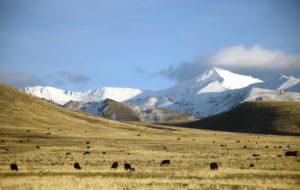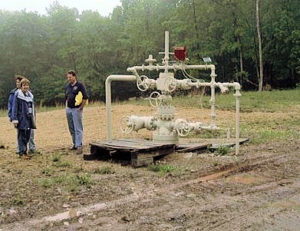Leasing of minerals occurs in different ways, depending on whether the minerals are owned by private citizens, or federal or state governments. In both situations, the owner of the minerals may be different than the owner of the lands that lie above the minerals. This situation is known as “split estate,” i.e., the mineral and surface estates are owned by different parties.
Leasing Public Minerals for Oil and Gas Development
Landowner Notification
The direct notification of individuals who own or lease land located above publicly owned minerals typically does not happen when the leasing of state or federal minerals occurs. Consequently, often surface owners do not realize that the mineral rights have been leased to a company that may use their land to access and produce the oil and gas underneath their property.
Some states do have processes for posting notices about lease sales on state lands. For example, the state agency in Montana will post notices on its web site, in local newspapers and they will send information about leases to a mailing list.
Federal Lease Sale Information and Maps
The BLM posts federal lease sale information and more general maps here.
Leasing Private Minerals for Oil and Gas Development
When minerals are owned by a private citizen or entity, oil and gas companies must lease the minerals prior to drilling for oil and gas.
A mineral lease is a contractual agreement between the owner of a mineral estate (known as the lessor), and another party such as an oil and gas company (the lessee). The lease gives an oil or gas company the right to explore for and develop the oil and gas deposits in the area described in the lease.
When you (the lessor) sign a lease you essentially become a partner with that company (the lessee). When a company holds a lease to your mineral property, you cannot lease those mineral rights to another company until the lease term with the first company expires. When the lease terminates, all rights to the minerals revert back to the mineral owner.
As with any partnership, open communication is necessary to maintain a successful relationship. A lease may be something that you may have to live with for many years – perhaps the rest of your life. Consequently, it is in your best interest to maintain a business-like relationship.
- Get everything in writing, and keep the lease in a safe, but easily accessible place. In the event the lease is lost, you should be able to obtain a copy of the lease from the county recorder’s office.
- Do your research. Ask neighbors, government agency staff or other mineral owners and landowners about the company, your potential business partner. It is important to know who you are dealing with before entering into a lease.
For more information and tips on leasing your minerals, download or order Chapter 3 of OGAP’s landowners guide to oil and gas “Oil and Gas at Your Door?”. Also, see the “For More Information” section below, for links to various groups that provide information on mineral leasing and royalty issues.
For More Information
Leasing of Public Minerals
- Regulations that govern the BLM’s oil and gas leasing program may be found in Title 43<, Parts 3000 and 3100 of the Code of Federal Regulations. General regulations pertaining to oil and gas development on federal lands are found in Part 3160.
- Environmental Working Group. Who Owns the West? Oil and Gas Leases web site. This site contains an investigative report on the leasing of federal minerals; interactive maps; state reports; and information on where the leasing has occurred and who owns the leases.
- Preserving Our Public Lands: A citizen’s guide to understanding and participating in oil and gas decisions affecting our public lands. A valuable resource citizens wanting to affect the way oil and gas development occurs on public lands.
Leasing of Private Minerals
- The Real Estate Center at Texas A&M University has information for mineral owners and surface owners. Topics include: Negotiating Leases; Scrutinizing Royalty Payments; Recovery of Surface Damages and Remediation Costs; Subdivision Drill Sites, and more.
- The National Association of Royalty Owners is geared toward mineral owners. They have free brochures, and paid publications on mineral deeds, leasing, How to Survive Force Pooling, and other topics.
- The Ohio Department of Natural Resources has produced a brochure entitled Landowners Guide on Oil and Gas Leasing.
- The Pennsylvania Department of Environmental Protection has produced a fact sheet called Landowners and Oil and Gas Leases in Pennsylvania. Penn State has a resource called Natural Gas Exploration: A Landowner’s Guide to Leasing Land in Pennsylvania.
- A Landowners Guide to Oil and Gas Leasing is a brochure produced by the New York State Department of Environmental Conservation, Division of Mineral Resources.
- Purdue University Agricultural Economics Department has produced a guide called Negotiating Oil and Gas Leases on Indiana Farmland.
- Land and Leasing. This manual, produced by PETEX Publications, is for landowners, landmen, lawyers, and investors as well as all oil company employees. It takes a laypersons approach to the legal aspects of land-ownership, transfer, and leasing, privately owned land; state and federal lands; preparations for drilling, producing, and selling; agreements to explore and develop leased properties; and pooling, unitization, and release. It uses examples from Alaska, California, Louisiana, and Canada, Kansas, Michigan, New Mexico, North Dakota, Oklahoma, Texas, and Wyoming.



